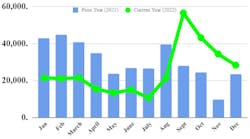The Class 8 truck outlook sits in a seemingly contradictory place: Orders to truck manufacturers keep dropping from one month to the next, but there are enough other indicators that two major trucking firms crunching the data, ACT Research and FTR Transportation Intelligence, see a relatively strong heavy-truck market.
In a post-new year’s release of its December preliminary order data, ACT saw “healthy” December Class 8 intake capping a “robust” final four months of 2022, when orders, according to ACT, actually declined steadily: soaring in September to a record 53,700, a “robust” but lower total of 43,200 in October, November Class 8 orders that fell to 33,000, and now a December intake of 30,300.
See also: Strong pent-up demand in Q4 for Class 8 trucks
FTR had preliminary December orders even lower at 28,300. Both FTR and ACT will post final numbers next week or the week after, as is their usual mid-month practice. But in the releases with their preliminary data, both saw positives in what's happening with new Class 8s.
“At first glance, December’s SA intake was 4% below the [year-to-date] monthly average heading into the month,” said Eric Crawford, ACT’s VP and senior analyst. “On the surface, and when combined with a 26% [month-to-month] decline on an SA basis, that might suggest some weakening in demand."
However, Crawford added: “But when factoring in the year-end seasonal uptick in orders began a month ahead of schedule this year (September), which skewed the [year-to-date] SA average upward, and that September orders represented the highest monthly total on record, we’re inclined to view December’s order intake as a solid end to a robust final four months of the year.”
“Class 8 orders are quickly moderating with a fall of 21% [November 2022 to December]; however, they compare favorably [year-over-year, December 2021 to December 2022] at 25% higher,” said a release posted on FTR’s website that accompanied its monthly data report.
Jonathan Starks, FTR’s CEO and chief intelligence officer, added: “Backlogs are still elevated but not at such a level that they can sustain significant deterioration without impacting production output. Despite these concerns, essentially all the production slots for the first half of the year are full and the second half of the year is starting to fill up as well."
See also: New commercial vehicle breakthroughs offer big advantages
Starks added: “The heavy vehicle market remains strong despite economic and financial uncertainties, and production will still be limited to some extent by supply chains and labor.”
As an aside, ACT’s Crawford added that “large cancellations, reflecting a multi-quarter correction in cancellation reporting, impacted the volumes at one of the large OEM groups, which had the effect of pulling down on December’s [medium-duty and heavy-duty] activity. While ACT does not have the data specifics at this juncture, the cancellations will be reported when December data are released mid-month.”
FTR’s release added: “There has likely been some end-of-year cleanup of the order boards as OEMs look to firm up their production schedules. Orders are now in line with sales and production levels, so any further reductions in incoming orders will start to eat into backlogs.”
Meanwhile, net Classes 5-7 orders were 17,700 units in December, according to ACT. About medium-duty order activity, ACT’s Crawford added: “MD demand was decent. December Classes 5-7 orders declined 17% [month-to-month] to 17,700 units.”
ACT still sees recession leading to lower Class 8 production
Three pre-Christmas releases from ACT Research showed how complicated the Class 8 production and market outlook might be this year.
On Dec. 22, in its Commercial Vehicle Dealer Digest, ACT said it continues to expect a recession that could translate into lower Class 8 production. The next day, the research firm observed slippage in its heavy-tractor “dashboard,” the seventh moderately downbeat reading in eight months.
The Commercial Vehicle Digest observations from ACT also spoke to the broader economy and trucking, that “the longer inflation remains elevated, the more aggressively the Fed will respond with higher interest rates. This increases the chances of a sharper decline in economic activity, and 1) results in fewer commercial vehicles required to facilitate this subdued activity and 2) will likely exacerbate downward pressure on spot and contract rates, adversely impacting carrier profitability.”
Kenny Vieth, ACT’s president and senior analyst, also observed: “We are already seeing the slowest [year-over-year] growth in the money supply since 1995, and that metric will turn negative in coming months. Recent economic data are inconclusive: The labor market continues to add jobs at a pace that implies too-hot wage inflation pressures, but the most recent core personal consumption expenditures reading indicates inflation may be moderating.”
In mid-December, ACT had a somewhat pessimistic view of 2023 in its ACT Freight Forecast, U.S. Rate and Volume Outlook. Of the outlook, research VP and senior analyst Tim Denoyer said: “While it’s not a particularly positive forecast for the near term, we believe the bottoming process is picking up speed and the loose market current conditions should rebalance over the course of 2023.”





